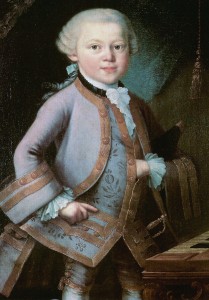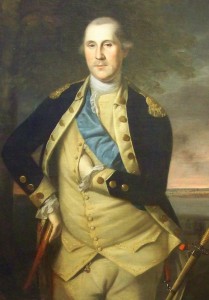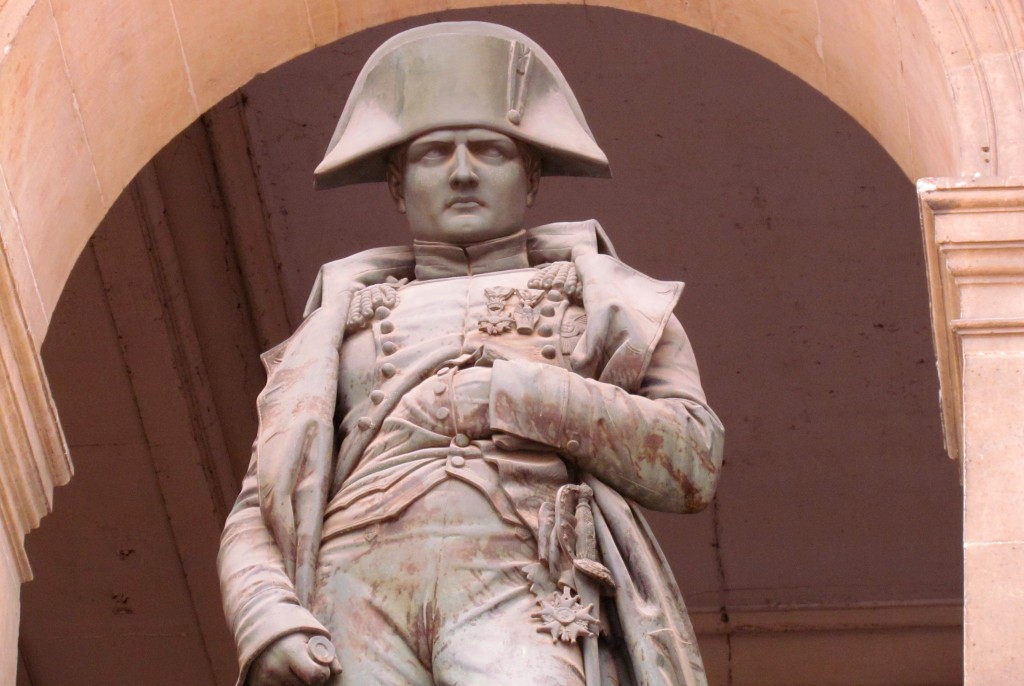If you want to mimic Napoleon Bonaparte, just stand straight and hide one hand in your jacket. It’s an immediately recognizable pose and unique to Napoleon, right?
 Like so many Napoleonic myths, there’s more here than meets the eye.
Like so many Napoleonic myths, there’s more here than meets the eye.
In fact, the one-hand-concealed stance can be traced back to the days of Roman togas and even to Greek statues dating from 350 B.C.E. More than a hundred years before Napoleon’s rise to power, it had returned to fashion and was considered a refined pose for a gentleman’s portrait.
I’ve included here a portrait of young Mozart in 1764 and one of George Washington in 1776, both painted years before Napoleon’s fame made the pose iconic to him.
 If you search the internet, you can find similar portraits of Joseph Stalin, Karl Marx, Simon Bolivar, the Marquis de Lafayette, Hosni Mubarak, and many others, all with one hand slipped inside their jackets.
If you search the internet, you can find similar portraits of Joseph Stalin, Karl Marx, Simon Bolivar, the Marquis de Lafayette, Hosni Mubarak, and many others, all with one hand slipped inside their jackets.
According to Napoleon-Series.org, “in 1738 Francois Nivelon published A Book Of Genteel Behavior describing the ‘hand-in-waistcoat’ posture as signifying ‘manly boldness tempered with modesty.’ ”
I agree that “manly boldness” describes Napoleon Bonaparte, but “tempered with modesty”?


I wonder if the posturing will make a comeback? I will be on the look out for such “manly boldness”! (And some female equivalent!)
This pose was a sign of Masonic membership. Being a secret society, apparently the word has not gotten out to everyone yet…
Hi, Randy, I’ve heard that but never seen any proof. If you or anyone else has a source, I’d love to hear it. Of course, my examples of George Washington and Mozart only support that theory–both were known to be Masons.
I wonder if the “modesty” thing might have been a bit of a ploy. I notice when Kim Jong Un appears before a vast crowd in North Korea, they always applaud him (they’ve no doubt been trained to), and he either applauds too, as if to share the praise equally with the people, or motions for them to sit down. It’s obviously a very elaborate show of false humility, and it produces the desired effect.
Sorry to compare Kim Jong Un with Napoleon. I know the latter had more charisma. 😉
Emma, you’re right in that leaders all around the world and throughout history have found ways look modest while encouraging their own praise. Part of being in power, I guess. Thanks for reading the blog and commenting.
The masonic “hidden hand” nor the secret handshake have anything to do with sticking your hand in your jacket, your friends jacket, or pockets even. It is a confussion of terms, a homonym of sorts which has gained traction in the minds of people who want to imagine napoleon and some other despots were free masons. It’s also akin to saying people who wear turbins are terrorists, or white men with shaved heads are all racist. Orange traffic cones must taste like oranges. So ignorance of a term, and a logical fallacy.
But who am I to say?
Yes, Spencer, I agree that Napoleon’s hand in jacket posture probably has nothing to do with Free Masons. As I said in the blog, in Napoleon’s time, it was simply considered a gentlemanly posture.
Hi Margaret,
Good luck with the book, what inspired you to write it?
Napoleon has always been a character who has interested me since my childhood and he consistently seems to be a character of contrasts. One of a few people who seem to inspire love and hate, hero worship and contempt.
I hope you find/have found your publisher, if so please advise I’d like to read your book.
Regards,
Ron Wood
Thanks for the good wishes. Like you, I’m fascinated by the contradictions in Napoleon’s personality, and the way people react to him, or actually react to the various mythologies about him. I wrote the book because I wanted to know who he really was as a person.
I’m still working on finding a publisher–and still editing the manuscript, too. I’ll let you know when to expect to see it come out.
Take care!
Margaret
Actudally i had a stomach ulser in which i did with and it was my waek spot so i covered it with my hand
It’s good to know this reference to your book was one of the top 3 answers provided to my question. I was thinking it would be a good way to cover up for a rotator cuff injury when standing for prolonged periods of time. I had heard about artists that couldn’t draw hands too. It’s nice to finally have an answer.
Glad I could help! Though that rotator cuff theory could work, too . . .
Margaret
I have rotator cuff problems. The Napoleon “pose” is one of the most comfortable positions for my right arm – supported by the buttons in my shirt.. Did Napoleon have a shoulder injury and wanted to avoid a visible sling for his arm?
Not as far as I’ve ever heard. I think it really was his attempt at a dignified posture.
Pingback: Finding Napoleon Bonaparte in Madrid – Part 2 - Finding Napoleon
Pingback: Here’s Why Women’s Shirts Button on the Opposite Side of Men’s | WELCOME TO PHILISA.COM
He had an ostomy, made of a goat bladder, and he was covering the opening with his hand as a precautionary measure to muffle potential sounds that may be emitted.
I’ve been known to strike the same pose at times. My hand under my coat is usually resting on my Colt 1911.
🙂
I don’t think that’s in the historical record, at least not anywhere I’ve seen. If you find a good source for the notion, please let me know.
I thought this pose was mostly because of the known difficulty in drawing hands? That artists would rather conceal them so the could focus their energy on the visage.
That may be an idea that came after the pose itself was being used. Sometimes, it’s hard to tell whether the chicken or the egg came first . . . Thanks for you thoughts.
Margaret
The same reason it’s done by Prince Harry, the current Pope, certain influential celebrities… Nothing to do with injuries, painting difficulties or ‘genteel posture’!
Napoleon never really did put his hand in his jacket! the painter only did that to make Napoleon like a gent
Yes, it was a common practice in that era to give dignity to the subject of the painting. Thanks for dropping by!
No, it was because Napoleon was a freemason. Fullstop. The hand in the tunic is a well-known freemasonic symbol, the “hidden hand”, the sign of the Master of the Second Veil, and there are loads of paintings and photos of important historical figures, such as your examples George Washington and Wolfgang Amadeus Mozart, making the same gesture. Both of these figures are known freemasons. As were your other provided examples, Joseph Stalin, Karl Marx, Simon Bolivar, the Marquis de Lafayette and Hosni Mubarak. It underlines the point that it’s a freemasonic symbol when the examples you give of recorded pictorial evidence of individuals with their hands in their tunics not being about freemasonry were all freemasons, don’t you think? Oh, and the positioning of his feet in many of the paintings also gives Napoleon away.
Napoleon Boneparte, the “Father of the Revolution” was a product of that same revolution. The French Revolution itself was a freemasonic creation, an established fact of history and documented by French Catholic Jesuit priest, Augustin Barreul, but also Protestant, mathematician, scientist, and professor of natural philosophy at the University of Edinburgh, John Robison. Robison became, in 1783, the first general secretary of the newly formed Royal Society of Edinburgh and is remembered as the author of several scientific articles for the third edition of the Encyclopedia Britannica. He was also a freemason. We can therefore deduce he knew what he was talking about.
And of course, Napoleon’s brothers, Joseph, Lucian, Louis, and Jerome, were also all freemasons. Five of the six members of Napoleon’s Grand Counsel of the Empire were freemasons, as were six of the nine Imperial Officers and 22 of the 30 Marshals of France. Then there’s the fact that Bonaparte’s rule had become the golden age for freemasonry in France. During the 18 years that he was in power, the number of freemasonic lodges in France increased from 300 to 1220.
When it looks like a duck and quacks like a duck, I’m afraid to say it most definitely is a duck.
What a great comment! I appreciate your insight.Despite a ton of research into this, I never got this exact answer. I’d love to know your source for Napoleon himself being a Freemason. Absolutely, I agree that his brother Joseph and other Bonaparte brothers were. Plus George Washington, Mozart and the Marquis de Lafayette, and many others in the French Revolution. My understanding was that Napoleon himself (at least officially) distanced himself from them after some initial engagement with them. You are sending me back to do more research and I thank you for it.
I will disagree with you on one point. Napoleon was not “the father of the French Revolution.” He spent much its early years in Corsica pursuing his political interests there. It wasn’t until 1793 that he made his name at the Battle of Toulon, and again in 1795 when he led the Revolutionary forces to clear the Royalists counterinsurgency in Paris. He did become a friend of Robespierre’s brother Augustin and was thrown in jail at the end of the Terror because of that association. Briefly, what he did do was save France and key tenets of the Revolution when France was bankrupt, spiraling out of control, and threatened militarily by the European powers. It was on that basis that he claim he “was the Revolution.”
Thank you so much for all the important points you made. By the way, there’s one more Freemason who helped Napoleon. On St Helena Island, Saul Solomon, the island’s most prominent merchant, reportedly smuggled messages for Napoleon and may have helped plan escape attempts.